CHANGE MANAGEMENT
Thank you for selecting us as your partner. We are proud to have earned your trust.
“Grit” is defined as perseverance and passion for long-term goals. Research shows it is also a predictor of success.
Entering the path towards optimised warhousing solution is starting a rewarding journey that will hold challenges and lead to change. A clear vision and defined targets help you stay on course and keep motivation high.
We are sure you and your organisation have grit. We can contribute with our experience from implementing a warehosuing solution, by offering a set of guidelines, tools, and tricks.
Browsing through these pages is time well spent. We promise.
We are on the path towards excellence through change
Implementing a warehousing solution is a big step. There will be noticeable changes compared to your current situation, and change will affect many people involved in your business. But you can prepare yourself to make this transition as smooth as possible.
- Have you allocated the right resources to the project?
- Have you started to discuss the change process with the people in your organization that will be affected by the project?
On these pages you will find information and useful tools for your journey to successful implementation.
Things do not change; we change.
– Henry David Thoreau
It’s time to get to work
This is our “PROMISE” process model. It teaches you the main activities in the different stages, and what activities are executed by whom. We also explain the expected outcome from each stage.
You will find an estimated work effort for each stage.
Having a process model where you can go back and forth between the stages helps you stay ahead in your planning.
Done. But the work is far from over… it starts now
It’s important to get everyone involved at an early stage. Provide an understanding for the reasons behind the change. What´s the goal with implementing this warehousing solution? Strive to get the individuals involved to see the system as a potential for a positive work environment and to improve operations, rather than being a threat.
What happens after you’ve implemented a new warehouse management system in your organization?
The surrounding world is not static and your warehousing solution is not static software. Minor or major changes are a part of everyday life, and the system should be managed, tweaked and trimmed to support your business going forward.
We might have left the building but we are never far away. As your partner we will stay by your side. To us that is the essence of our company; Together We Get There, Strive For Greatness and Be Accountable And Act.
Enabling change
Change management is a structured approach to achieve change in individuals, teams and/or organisations. Enabling change from an existing state to a new future state.
Change increases uncertainty. Resistance to change is often when people see change as a threat. Change can divide groups, change status, roles and hierarchies. Change often requires new types of expertise.
Before anything else, preparation is the key to succes
– Alexander Graham Bell
Get the right people
We believe in people who want to make a difference. Things get done better with a well-functioning team.
But who are your “right people”?
Experience from hundreds of implementations have taught us what roles and requirements you need in your project team. We would like to share this valuable knowledge with you. Add your insights regarding your team and resources to ensure a perfect match between role and person.
Working with a warehousing solution means that new knowledge becomes important. From having focus in know-how about item and location, to focusing on IT-tools, having a high level view of the solution and being able to identify improvements. In other words, to continue to take full advantage of the system as the business process changes.
Get everyone involved early
It’s important to get everyone involved at an early stage. Provide an understanding for the reasons behind the change. What´s the goal with implementing this warehousing solution? Strive to get the individuals involved to see the system as a potential for a positive work environment and to improve operations, rather than being a threat.
Project group
The composition of the project team is important. The size of the team and the time spent depends on the time frame for project, availability, complexity and the size of operations.
The different parties/roles need to do different amounts of work depending on where you are in the project. In some stages the majority of the focus is on us, in other stages the focus is on you.
It’s important that your organisation participates with energy in the different project activities, is focused and not disturbed by daily business.
Steering committee meetings are central to the project process. The meetings prevent problems or take decisions about new circumstances before they occur. Their work is preventative, not about putting out fires. The steering committee consists of project managers and representatives from the management from both parties.
Focus: Project Manager
Your project manager is the overall manager for project implementation. They are responsible for coordination of activities from different parties (Consafe Logistics, your organisation, ERP interface consultant etc.). If your project manager doesn’t have experience in managing an IT implementation it could be a good idea to provide external support in this area.
Focus: Super User
Super users are people with thorough knowledge of the system. They know the warehousing solution to the extent that they can train your staff in how to work with the new solution once in place.
Focus: Business Expert
Business experts are central to the discussion and decision making on how to work with the new system. It’s important to have a good knowledge of demands, be able to take decisions regarding new ways of working and be flexible and prepared to change the way of working. A Business expert can be a process owner or the warehouse manager.
Focus: End User
It is important to involve end users. These are the guys that will work in the solution.. These people do not necessarily need to be part of the project group, but they need to be involved during the whole process. Their involvement can be everything from reading about implementation in the corporate weekly letter to assisting in test scenarios.
Focus: Server and Infrastructure responsible
The IT technician with focus on server and infrastructure will be responsible for the set-up of server and infrastructure according to the system requirements of Astro WMS®. This role can be held either by resource from customer internal IT department or outsourced IT supplier.
Focus: Integration Expert
The IT technician with focus on integrations to ERP/TMS will support the Business experts during the specification phase, making sure that the processes defined are also supported by the communication interface. This role can be held either by resource from customer internal IT department or by consultant working with ERP and /or TMS.
Preparations Best Practice
Contribute to the list of inspiring examples by sharing your learnings with the Consafe Logistics project manager. Sharing an idea is always a good idea.
Need change management support? Contact Consafe Logistics project manager, and they will advise you.
Start building up awareness about the change. It is important to keep people in the loop. This can be done in different ways:
Continuously post news about the progress of the project in your internal newsletter
Place information in the dining room
Have a computer with a demo easy available where people can take a look at the new system
- Project Initiation
- Specification
- Configuration & Development
- Testing & Commissioning
- Go live Preparation
- Go live & Handover
The process
The project process consist of six stages. Get an introduction to each step by clicking on the tabs above. The process starts with the first meeting and is active until the warehouse management system is live in your warehouse. Our project process is called PROMISE.
- Project Initiation
- Specification
- Configuration & Development
- Testing & Commissioning
- Go live Preparation
- Go live & Handover
How long time in each stage?
The project process has six stages. Each stage takes different amounts of time depending on how big the project scope is.
- How advanced is the project? Major changes in internal processes? Major technical challenges?
- Will the warehouse need to be rebuilt?
- Will the new solution require new equipment?
The following pages will give you an estimate of the time spent. Click on the tabs above to read about each step of the project process.
Picture the project lifecycle as a timeline where 0% represents the project has not yet started and 100% means that you are running operations by yourself. We can give a rough estimation on each stage of the project.
The first two stages, Project Initiation and Specification take place within the first 10-15% of the timeline. In these initiating stages, all conditions are set. Now it’s time for us to transform all gathered knowledge of your warehouse processes and bring it into the warehouse management system.
When approximately half the project live cycle has been spent it is time for Test & Training. This
It’s time to test the system and functionality. At 70% it is time to plan the Go-live. Training and getting to know the system is a big part of this stage. When we have reached 90% of the project lifecycle it is time for Go-live.
100% the project is now completed.
The estimated duration is illustrated by these boxes, where one box roughly represents 10%.
Your involvement
To implement a warehousing solution involves consistent work from both parties to achieve the best result.
On the following pages a graph illustrates the degree of involvement in the different stages, and related content related to the key roles; Project Manager (PM), Business Expert (BE), Super User (SU), End User (EU), Server and Infrastructure responsible (SI) and Integration Expert (IE).
In this step the project managers make a detailed schedule for all activities throughout the implementation project. The Consafe Logistics project manager is responsible for activities conducted by Consafe Logistics. Your project manager is responsible for activities executed by your organisation. The forms for coordination between upcoming activities are set.
How long is this stage?
This is a short but intense period; about 5-7% of the total project efforts.

Output from this stage
The roles are set and contact ways are confirmed. The time plan, a communication plan and defined project objectives are clear outputs.
Your involvement?
It mainly involves project managers.
Focus: Project Manager
Focus on identifying the different roles in the project and establishing contact.
Focus: Business Expert
Identified and appointed during this step.
Focus: Server and Infrastructure responsible
The person who is responsible for server and infrastructure will start taking a deeper look at the system requirements for Astro WMS® and help Project Manager to plan activities related to server and infrastructure.
Focus: Super User
Identified and appointed during this step.
Focus: End User
No activity in this stage. Perhaps post news in a weekly letter or on a billboard about project initiation?
Focus: Integration Expert
No activity at this stage.
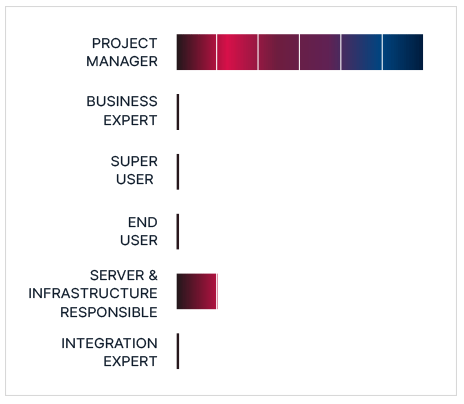
The specification phase, including all requirements defined and agreed upon, is completed/conducted. This includes site visits and detailed discussions regarding business process needs. Discussion regarding interface(s) to external system(s) is a part of the pre-study. Integration with your ERP system is an example of this. This is a very important stage for a good end result of the whole implementation.
How long is this stage?
This is a hectic time for most project members; about 15-20% of the total project time.
Highlight in this stage
How to merge your business and the warehouse management system? Identify the important processes, flows in and out.
Get to know the functions in the warehouse management system. New features replace old processes?
Output from this stage
This step results in several key deliverables:
- Interface documentation
- Clearly defined requirements documents with identified list of change requests (when required)
- Budget
- Approved configuration for the warehouse layout and article master, etc.
To proceed we both have to sign off on the above. It is important that we have the same vision of the scope.
Your involvement
This stage involves the whole project group and is intense for all. It is important to bring a high knowledge of business processes and an open mind for changing business processes to optimize the use of the warehouse management system.
Focus: Project Manager
Administrate meetings, protocols. Check time plan.
Focus: Business Expert
Specification of flows in and out of the warehouse
Focus: Super User
Training to get to know the warehousing system. General terms.
Focus: End User
No actual involvement. Seize the opportunity to prepare for what is to come with continued internal communication. Maybe it is time to post news in the cafeteria?
Focus: Server and Infrastructure responsible
Support the specification team in questions/discussions concerning server and infrastructure.
Focus: Integration Expert
The integration Expert has an important role in the specification phase. Attending the workshops to verify/align that the business processes discussed can be supported by the integration to other systems such as ERP and TMS. The integration expert is also responsible for the alignment with ERP/TMS consultants.
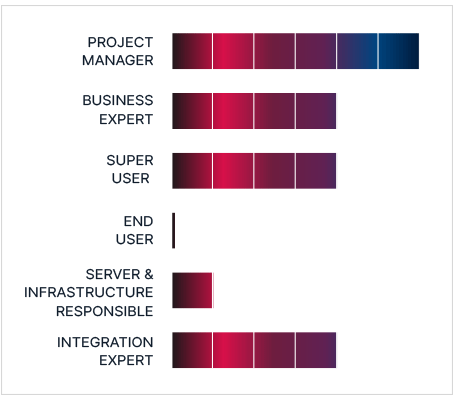
Now it is a time for a mix of configuration and development to adapt the warehouse management system to fit your solution. This stage includes everything from tweaking parameters to writing new code. It also includes preparing servers and infrastructure.
How long is this stage?
This is in the main part of the project; around 30% of the total project efforts. The length depends on the number of ordered change requests (specific adaption to your physical environment and/or business processes).

Output from this stage
Your new warehouse management system is now set up. Requested changes are developed and implemented into the system.
Your involvement
In this stage it is mainly the Consafe Logistics project team that are active. But it is important that you are available to support the team with specific information, like what users to add, general article information and other questions that may arise when the specification is divided into its components.
Focus: Project Manager
Focus is on the time plan. The project manager should be available for information/clarification of parts in the configuration. Prepare for new circumstances that may arise.
Focus: Business Expert
As the project manager, the business expert needs to be available for information/clarification of parts in the configuration. Is there going to be any rebuilding? Would there be any changes in the infrastructure/WLAN?
Focus: Super User
You need to be available for information/clarification of parts in the configuration.
Focus: End User
No activity at this stage
Focus: Server and Infrastructure responsible
Now it is time to get the servers set up and also to prepare the infrastructure related to that such as network, PC’s, user account, administrators etc.
Focus: Integration Expert
During this phase the integration expert should be available in case questions regarding the system integration arise. They can also support the vendors with sample data if that is needed for early offline test of the integration.
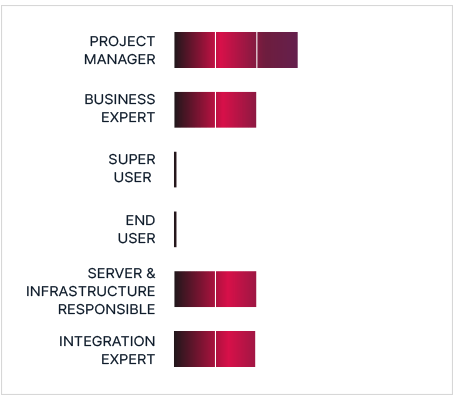
Consafe Logistics conducts an overall test and integration test in-house. When this is done, it is time for the Factory Acceptance Test (FAT). Now you can try the system. Does it work as expected? You will also receive training in the system. You work with your own items and layout. This stage ends with a SAT (Site Acceptance Test) when you test the solution in your own premises.
How long is this stage?
Around 20% of the project efforts goes into this phase.

Pareto Principle
Vilfredo Pareto
Originally, the Pareto Principle referred to the observation made by Vilfredo Pareto [1848- 1923] that 80% of Italy’s wealth belonged to only 20% of the population. This principle has later been applicable in different areas. The principle is also known as 80/20. It states that 80% of effects often come from 20% of the causes.
Why talk about this principle?
It can be applicable on the test process. 80% of test cases are “happy flows” (normal flows) that take 20% of the time, when 20% of the test cases include more specific factors that will take 80% of the time.
Normal flows in the warehouse management system need to be tested. But also all “If’s” or “What about’s” or “How’s”.
Create test cases in ERP systems. Configure test data to new circumstances. Create errors in transactions that can be followed up. What happens when there are exceptions to be handled? The test itself may not take that long to conduct, but the preparation can be time consuming.
Output from this stage
All angles of the warehouse management system are tested. First by us and then by you. All personnel involved with the system should have be trained according to their position.
This is phase is completed with the customer signing the Acceptance Test Protocol.
Your involvement
This is an intensive stage. All roles are busy. During the SAT it’s important not to focus just on the warehousing system. The overall solution (like communication with ERP and other systems) needs to be tested and confirmed that it works for the business needs. You are responsible for the planning, arrangement of the test plan, carrying out acceptance testing and the documentation of testing reports/protocols.
Focus: Project Manager
Involved in FAT, communication tests and SAT.
Focus: Business Expert
Involved in FAT, communication tests and SAT.
Focus: Server and Infrastructure responsible
Support the project team with trouble shooting in cases concerning server set up and the infrastructure. If test server for future deployment tests has not been set up previously, it can be done during this phase.
Focus: Super User
Involved in FAT, communication tests and SAT. The super user is also part of additional training concerning the warehousing management system according to the train the trainers concept. Super users learn the system in order to teach it to end users.
Focus: End User
Involved in FAT, communication tests and SAT. End users will also have training sessions with the super user.
Focus: Integration Expert
Now the integrations between the systems should be tested. The integration expert supports the tests and help with creation of valid test data if needed. If errors are identified during the tests, the integration expert also contribute with trouble shooting and case investigation.
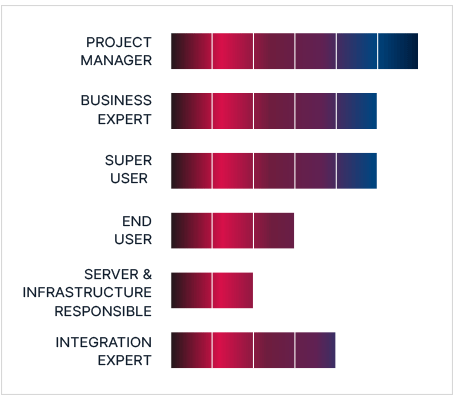
In this stage we focus on preparations such as end user training, cut-over/fall back plan and migration testing.
How long is this stage?
This is an intense phase. Approximately 10% of the total project time is spent here.

Output from this stage
Create an agreed plan for go live. Our Customer Service organisation is involved and the last details in the support contract are decided upon.
The Steering group evaluates the preparations done and decides if the project is ready for Go live
Your involvement?
The amount of support you need from Consafe Logistics depends on your staff’s knowledge level. Make sure you have given the right people sufficient training to be ready when the action starts. Sometimes it is wise to have an extra team ready to step in if a surprise occurs.
Checklist for success:
- Does everyone involved know enough about the new processes, system and equipment?
- Are all prerequisites in place?
- Are all tests done and related tasks completed?
- Have you removed test data from the system’s database?
Focus: Project Manager
This stage will contain a lot of planning. Are the bullets above fulfilled? Are there any issues in implementation that have been postponed until a later time? Are your processes sufficient? Is there any need for small changes to create more efficiency?
Focus: Super User
You should take the time to learn more about the warehouse management system, and train colleagues.
Focus: Business Expert
Now the system is tested, does the physical environment (rebuild etc.) meet technical requirements? Does the warehouse infrastructure work as it should?
Focus: Server and Infrastructure responsible
Supporting the acceptance tests and preparation for Go-live. This also includes reviewing the migration plan with technical expertise and securing that all aspects of the IT landscape at the customer is taken care of.
Focus: End User
There is a high focus on end users. Let them spend time working with the system to get to know it. Try it. Test it. Taste it.
Focus: Integration Expert
Supporting the acceptance tests and preparation for Go-live. This also includes reviewing the migration plan with technical expertise about the integrations and how masterdata can be migrated into Astro WMS®.
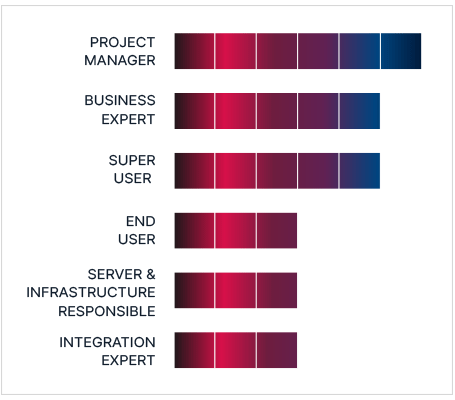
The Go-live stage includes the days from go-live date until signed Inspection Period Protocol (defined weeks after go-live). This stage also includes System Administration training. This is more thorough training where you dig even deeper into configurations and parameters. Learn how to use the toolbox to make the most of the warehouse management system to support your organization.
How long is this stage?
Up to 10% of the estimated time is spend in this final stage.

Output from this stage
Your warehouse management system is now up and running. You are taking advantage of your new tool to boost efficiency, control and flow in your warehouse.
Review the implementation project. What went well? What can be enhanced? Did we stumble upon any significant matters? What can we learn together from this project?
Open issues/Final acceptance to contract is decided upon. Larger open issues must be notified to Consafe Logistics as soon as possible after go-live. This leads to the last document to sign – Inspection Period Protocol
Starting the support agreement
It’s time to say goodbye to our project team and hello to our Customer Service team.
Your involvement
During the go-live stage we support you both on and off-site. Our responsibility is to secure that the warehouse management system works. Questions from the “floor” are handled by your super users if nothing else is decided.
Focus: Project Manager
Control of the open issue list. Plan resources. Do processes work as intended? Build relation with your customer contact at Consafe Logistics.
Focus: Business Expert
Monitor the processes to ensure that the warehouse flow is running smoothly. Do we need to smooth out areas where we have cut corners?
Focus: Super User
Start working with the system in the new role. Be the person offering help and support to end users. Have the ability to answer questions like, “Why are we doing it in this way?”, “What does that function do?”.
Focus: End User
Hands on in a real-life situation with actual orders. Get to know how to perform your work in the most efficient way.
Focus: Server and Infrastructure responsible
Monitoring that the servers are functioning as planned, for instance that backups are taken, performance is ok etc.
Focus: Integration Expert
Supporting the Go-live, specifically monitoring the intregrations and that the transaction flow works as defined. Assisting project team with trouble shooting if incidents appear.
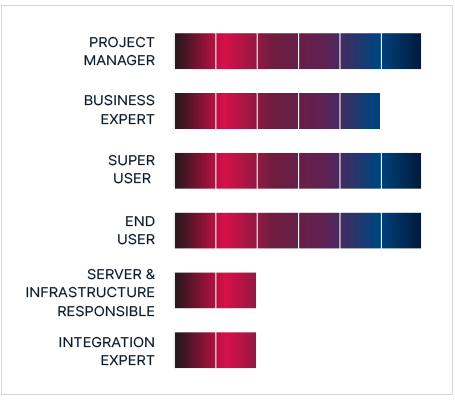
From big change to “business as usual”
When your solution has been implemented you will start to work with your warehouse management system. After training, trimming and configuring this will soon be the most natural part of your daily work. When an unexpected change occurs in your process you will be the expert on the new solution.
You can design and create, and build the most wonderful place in the world. But it takes people to make the dream a reality. Walt Disney
Keep the new process and routines alive
It is important to have an organisation everyone knows within the warehouse and to be able to follow up new routines and processes. You not only need to keep the new processes and routines alive, you’ll need to tweak and trim them to become even more efficient.
Tools to use can be:
- Clear instructions of tasks/responsibilities
- KPI’s (Key Performance Indicators), an easy way to illustrate progress
- Regular meetings (group meetings) follow-up on progress or problems
Tweak and trim your system
Tweaking your warehouse management system is a process of improving the performance of an application or the quality of its output. In time you will know the system and its possibilities very well—then you can adapt and fine-tune your system by adjusting configuration and parameters by yourself.
Continue with training
It is very important to train end users, and you need to translate the use of the system to an overall training scheme, explaining how to handle different situations. Training should contain activities using the warehouse management system and using it together with other system in your organization.
It’s important to give an overall understanding of the solution and provide tools to handle special situations. For example when something breaks, is misplaced or missing.
Customer Service
Consafe Logistics is just one phone call away.
Our Customer Service gives your business peace of mind, knowing that our qualified and reliable experts are available within minutes. Our experts and processes offer all the support you need to resolve any issue, whenever it occurs. You can be secure in the knowledge that you won’t waste valuable time on costly breakdowns or production stops. We have experts to help you when you need them to answer questions or solve any problems that might arise – quickly and effectively.